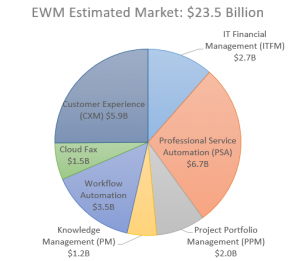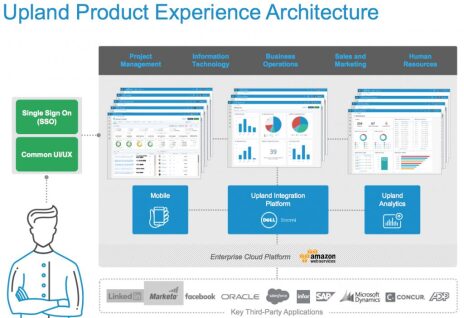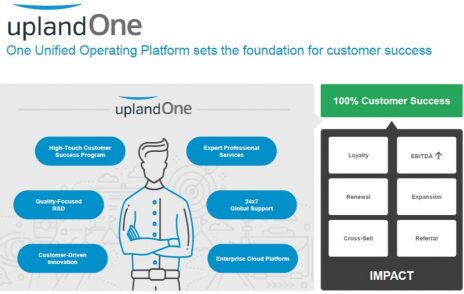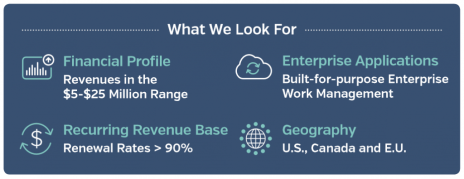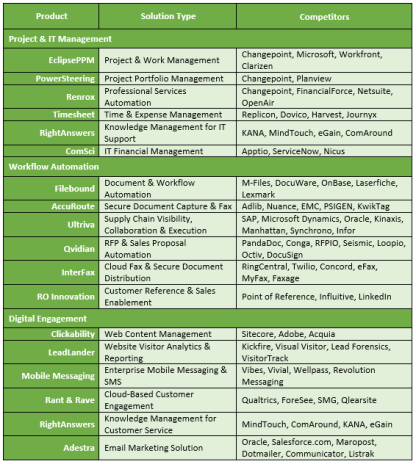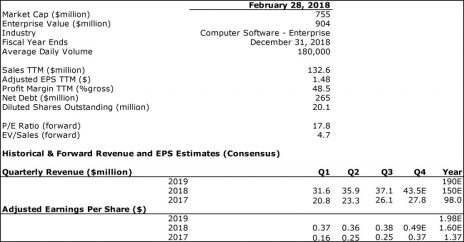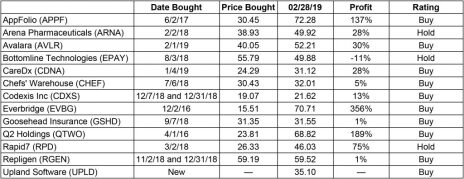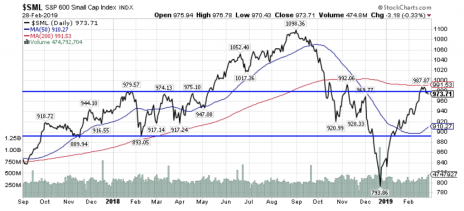Today’s opportunity is a cloud software stock that’s recovered nicely from its December lows and is moving back up near its 2018 high.
The company is growing quickly, mainly because of an acquisition-led growth strategy. Evidence is building that organic growth is starting to kick in too now that the company has acquired enough solutions to start bundling them into product suites.
This M&A growth strategy is a slightly different one than pursued by the other cloud software vendors in our portfolio. I think it’s compelling. And if I’m right that organic growth will be steadier moving forward, we should see shares perform very well in 2019 and beyond.
Cabot Small Cap Confidential 238
[premium_html_toc post_id="171894"]
THE BIG IDEA
Nobody wakes up in the morning and says, “I’m fired up to buy stock in an Enterprise Work Management software company today.”
But not all investment ideas are sexy. Or make for a good story to tell friends. Or even sound a little bit exciting. They’re just good, solid ideas that should help a portfolio deliver big gains over time.
That’s the case with the company I’m profiling today, which, as you already know, specializes in Enterprise Work Management (EWM) software.
The pitch starts with a broad look at how developed economies work today. Decades ago, economies were more reliant on agriculture, extractive industries and manufacturing. Over time, as people became more educated and developed new skills, many economies (U.S., Europe, Canada, etc.) have gravitated toward activities like healthcare, information technology, education, engineering, research & development, etc.
The buzzword for this type of economy is the Knowledge Economy.
Stanford professors Walter Powell and Kaisa Snellman defined the Knowledge economy thusly:
“We define the knowledge economy as production and services that are based on knowledge-intensive activities that contribute to an accelerated pace of technical and scientific advance, as well as rapid obsolescence. The key component of a knowledge economy is a greater reliance on intellectual capabilities than on physical inputs or natural resources.”
You’re intuitively aware of this transition to “intellectual capabilities,” even if you haven’t spent much time thinking about it.
For instance, many years ago car manufacturing was about fabricating metal and tightening nuts and bolts. Now, a car is a smart machine full of computer chips.
Not long ago, retailers tracked shopper activity based on in-store activity. Now, it’s all digital. Even small online retailers use powerful technologies (filtering, data-tracking and customer service tools) that are easily delivered via the cloud.
Not all that long ago, Cabot would print and mail out this Issue of Cabot Small-Cap Confidential. Now, you receive it digitally, the same day we put the finishing touches on it! We are heavily reliant on knowledge-intensive activities to make this happen.
This is the Knowledge Economy, and the throngs of knowledge workers are still growing. They collaborate in dynamic work environments and virtual teams, all over the world.
To get things done quickly, efficiently and accurately, they need powerful tools specifically designed for the modern work environment. Tools that allow for collaboration, communication, project management, customer service, marketing, and more.
In short, they need Enterprise Work Management (EWM) solutions. These software solutions are designed to help knowledge-based workers get things done. They’re not particularly thrilling to talk about. But man, if you’re a knowledge worker and you don’t have the right tools, work can be very, very frustrating. Your company’s performance can suffer too.
There is huge demand out there for EWM solutions. Aggregated estimates put the total addressable market just north of $23 billion. This pie chart breaks it down into bite-sized chunks.
The market for EWM solutions is still very fragmented, with a lot of small companies delivering specialized solutions that do one thing very well. The problem is that organizations, and especially larger enterprises, don’t want to deal with a lot of software vendors. They want to consolidate solutions to a few of the best providers out there.
The company I’m profiling today is answering their call for simplicity, acquiring pure-play providers of powerful EWM solutions and rolling them onto a common platform powered by Amazon Web Services. For the last six years it’s been doing this and is now at the point where it can start to bundle these solutions together into powerful suites, like Customer Experience Management (CXM).
The Big Idea here is equal parts about the potential in the EWM market and the potential for this company to deliver highly profitable growth by following an acquisition-led growth strategy, supplemented by steady organic growth.
THE COMPANY
Upland Software (UPLD) is a $761 million market cap company that provides cloud-based Enterprise Work Management (EWM) software to companies where collaboration and teamwork are critical to their operations.
This software is designed primarily for people in mid-to-large organizations (Upland has small customers too) that work with other people and partners, in dynamic, knowledge-based work environments, all over the world. Users are familiar with the ins and outs of technology systems. And they need easy-to-use, yet powerful, solutions that can reduce manual processes and allow for better collaboration, visibility, execution, customer engagement and productivity.
Upland Software’s solutions are designed to help get things done. It has 18 solutions, spanning three main product families:
Project and IT management: Allows users to manage an organization’s projects, professional workforce and information technology (IT) costs. Believed to represent a $12.6 billion potential market.
Workflow automation: Allows users to streamline, optimize, automate and secure document-intensive workflow business processes across their enterprise and supply chain. Believed to represent a $5 billion potential market.
Digital engagement: Permits users to engage with current and potential customers through web and mobile technologies. Believed to represent a $5.9 billion potential market.
The Texas-based company was founded by Jack McDonald, who was previously the CEO of Perficient (PRFT), a digital transformation consulting firm. While at Perficient he took the company from startup mode to 1,200 employees and completed 17 acquisitions. He’s taking Upland Software in a similar direction, trying to capture as much as he can of the company’s $23.5 billion addressable market.
Upland may be a relatively small company, but its customer base includes major players across virtually all industries, from financial services, retail, tech and manufacturing, to legal, consumer goods, media, telecom, healthcare and life sciences. They all turn to Upland for purpose-built cloud-based products, a 100% customer success commitment, and the scale and resources needed to deliver reliable and powerful EWM solutions.
Well-known customers include Fidelity, Goldman Sachs, Bank of America, Microsoft, Amazon, Adobe, Samsung, Autodesk, HP, Disney, Pfizer, Siemens and UnitedHealthcare. All in, Upland says it has over 9,000 customers and 1 million users. Around 80% of revenue comes from the U.S., 16% from Europe, and 4% from Canada.
There’s no doubt Upland’s growth trajectory has been impressive. Since going public in 2012 revenue has grown at an average annual rate of 35% (assuming Upland hits Q4 2018 guidance when it reports next Thursday, March 7). In 2018 revenue is expected to be up by 58% to $150 million. EPS should have grown by 17%, to $1.60.
THE PRODUCT
Upland sells cloud solutions that address specific business needs across the three broad product families of Project and IT Management, Workflow Automation, and Digital Engagement.
Solutions can be categorized into five specific functional areas that match up with how customers use Upland’s solutions, and how sales teams pitch them. They are (1) Project Management, (2) Information Technology, (3) Business Operations, (4) Sales & Marketing and (5) Human Resources.
Altogether, Upland sells 18 different solutions (for a detailed breakdown of all its solutions refer to the “Competition” segment of this report).
One of the big selling points of Upland’s solutions is the UplandOne unified operating platform. Users simply log in to access all solutions, which run on a common user-interface, with one set of credentials (this is called single sign-on), from any device of their choosing. This is the inherent benefit of the cloud and is made possible because Upland has moved all solutions to Amazon Web Services (AWS), which also allows for integration with other third-party app providers. The accompanying image of Upland’s product Architecture puts this all in visual terms.
It’s not exactly unique that Upland offers everything on a common platform. A lot of software companies have similar delivery models. But investors must remember that the EWM market is very fragmented, so it is an advantage in this industry, at this time.
Upland now has enough solutions to start bundling them together into product suites. This should help it land bigger deals. A recent example is the Customer Experience Management (CXM) suite, which includes mobile messaging, customer engagement and knowledge management solutions. CXM is a big buzzword and is intended to be the next-generation of Customer Relationship Management (CRM). The recent Adestra and Rant & Rave acquisitions were big steps in building out the CXM suite (more on these in a minute).
It’s early, but recent results show evidence of larger deals. In Q3 2018 the company landed 12 accounts that averaged over $140,000 in annualized recurring revenue (ARR), versus six accounts of this magnitude in Q3 2017. Many more committed to over $100,000 in ARR, as did several existing customers that opted to purchase additional solutions. Forty-seven customers increased their ARR by at least 25%. Those numbers don’t include the two latest acquisitions, so it will be very interesting to hear what management has to say on this front on the next quarterly conference call.
Cross-selling potential has also grown as Upland has acquired more solutions. On the Q3 2018 conference call, management said roughly 1,200 of its accounts are big accounts and drive 80% of recurring revenue. That works out to around $100 million in ARR per account, and each account averages just one product. If it succeeds cross selling into these accounts the company could double, triple or even quadruple revenue without landing any new clients at all. Obviously, management wants to land new customers (it landed 130 new customers in the third quarter) but with just a little imagination you can see how this business can grow significantly.
The bottom line here is that the rollout of the UplandOne platform makes for a simplified and more efficient product offering. UplandOne also facilitates better customer service, which in turn helps customer retention. This is all helping the bottom line, and it’s beginning to catch the eye of analysts.
Upland’s Acquisition-Led Growth Strategy
Upland has a history of buying purpose-built, cloud-based EWM applications then restructuring and integrating them to help grow overall company revenue, profitability and customer count. It closed 20 acquisitions from February 2012 through 2018, and most of these complementary technologies/products/businesses are now generating organic growth.
Management has laid out a clear M&A strategy. Its target is to add over $25 million in revenue per year by snatching up companies with $5 million to $25 million in annual revenue and with renewal rates of 90% or more. Target companies must have EWM solutions that fit within Upland’s three product families and have operations in the U.S., Canada and/or E.U. Each acquired solution is intended to be migrated to the UplandOne model within three months.
Furthermore, management is looking for solutions where major accounts are spending at least $50K to $70K a year, with some implementations of $200K to $500K. Such accounts speak to the robustness of the solution. Management also says it wants to see gross margins of 70% or more. Most of these smaller businesses are likely operating around break-even.
When brought into the UplandOne model, management expects to move them to a 40% to 50% contribution model. That means some customers will drop off, but those that stay will be loyal and more likely to purchase additional products over time.
Recently, management has begun to see more compelling M&A opportunities in Europe. Here are details on a few recent acquisitions:
In December 2018 Upland acquired Adestra for $56 million. Adestra provides enterprise-grade email marketing, transaction and automation software to over 400 customers. The company will be combined with other solutions in the Digital Engagement product family. Adestra should add around $18 million in annual revenue ($16.7 million recurring) and roughly $8 million in adjusted EBITDA, once integrated.
In October 2018 Upland acquired Rant & Rave, which provides cloud-based customer engagement solutions, primarily in Europe. Over 100 customers use the solution to capture, analyze and act on real-time customer and employee feedback across mobile, SMS, email, web and social media channels. Rant & Rave resides within the Digital Engagement product family. The purchase price was $58.5 million and adds roughly $21 million in annual revenue as well as approximately $9.5 million in adjusted EBITDA, once integrated.
In June 2018, Upland paid $12.5 million to acquire RO Innovation, a provider of customer reference solutions. RO Innovation will be combined with Qvidian, Upland’s RFP and sales proposal automation solution. The acquisition adds roughly $6 million in annual revenue ($5 million recurring) and $2.5 million in adjusted EBITDA, once integrated.
The Business Model
Upland Software generates the bulk of its revenue (around 91%) from subscription services and support. This is referred to as recurring revenue. A small chunk of revenue (around 6%) comes from professional services, and a tiny amount from perpetual licenses (3%). Software applications are mainly sold through a direct sales force, with a smaller portion of revenue coming through an indirect sales organization that sells to distributors and value-added resellers (VAR). The company tries to “land” a client by selling an application or two that meets a client’s most pressing needs, then “expand” the relationship by cross selling additional EWM applications over time. As detailed above, Upland is pursuing an acquisition-led growth strategy that focuses on integrating new solutions and improving their profitability first, then working on cross selling and product bundling afterward.
The Bottom Line
Upland’s growth has accelerated as the acquisition-led growth strategy has kicked in. In 2017, revenues expanded by 31% to $98 million and adjusted EPS grew by 372% to $1.37. In Q3 2018 revenue was up 42%, to $37.1 million, and EPS rose 52% to $0.38. For the full-year 2018, management has guided for revenue of $148.2 million (at the midpoint) and adjusted EBITDA of $52.4 million (at the midpoint). Analysts see revenue of $150 million (up 58%) and EPS of $1.60 (up 17%). Management’s guidance accounts for the Adestra acquisition.
Organic revenue has also just begun to accelerate, rising by around 6% in Q1, 6% in Q2 and 7% in Q3. That might not sound like a ton. But remember that Upland has been in acquisition and integration mode and as acquired businesses are moved over to the UplandOne operating model there is always going to be some customer attrition. Organic growth measures the growth of products that have been part of Upland’s portfolio for over a year, after the peak attrition period has likely past. It’s a great sign that Upland is starting to deliver organic growth, even if it is relatively modest. That all said, management says it will continue to be conservative with respect to guidance on this measure.
Turning to other metrics, we’re seeing nice momentum. Annualized recurring revenue (ARR) was up 46% in Q3. Adjusted EBITDA, a measure of earnings, was up 57%, bringing Upland’s adjusted EBITDA margin up to 37%. That’s just 3% from management’s long-term goal of 40%. Finally, in Q3 2018 operating income was $0.3 million, up from -$2.3 million in Q3 2017.
Management updated its cash position in early December following the Adestra acquisition. Upland’s credit facility was expanded to $400 million, and it had $285 million in gross debt (at 6.3%) and $265 million in net debt, implying $20 million in cash. Using the most recent figures Upland has a current net-debt-to-EBITDA ratio of around 5.0, but that is very inflated since it doesn’t account for a full year of EBITDA from the most recent acquisitions but does account for all the debt needed to complete them.
In 2019 analysts see revenue growing by around 27% to $190 million. If we assume an adjusted EBITDA margin of 37% then 2019 adjusted EBITDA should be around $70 million, give or take. Using that figure a more accurate reading on the net-debt-to-EBITDA ratio is 3.8, which is much more palatable. As a reminder, this debt ratio is a good estimate of how many years it would take Upland to pay down its debt at the current operating level.
RISK
Foreign Currency: With 20% of revenue coming from Canada and Europe, Upland faces some foreign currency exchange risk.
Keep an Eye on Net-Debt-To-EBITDA Ratio: Upland’s current multiple on this measure of 5 is inflated (as discussed above) and is closer to 3.7 using 2019 estimates and current net debt. The company can’t take on too much debt due to covenants, but as a practical matter investors will still want to make sure management communicates its debt load strategy on a regular basis, and always has the earnings power to pay it down.
Debt-Fueled Acquisition Strategy: Upland’s acquisition strategy means financing M&A activities with debt. This is fine so long as the acquisitions perform as expected, no so great if they don’t. And not so great if Upland needs to refinance a lot of debt at a higher interest rate in the future. At the moment the company generates cash from operations and pays minimal taxes, so all is fine. But debt is something to keep an eye on.
Lack of Attractive Acquisitions: Upland needs attractively priced acquisition targets to keep its growth strategy going. If opportunities dry up, or if it makes mistakes and buys companies that don’t work out, or overpays, future growth could be impaired.
Organic Growth Not a Forgone Conclusion: Acquisitions are great … until they’re not. We haven’t yet seen if Upland can generate regular organic growth, year in and year out. When the time to do so comes, if it’s not able, the stock will likely suffer.
COMPETITION
Upland competes with a lot of players given that it currently has 18 products. I’ve included all products (grouped by product family), as well as their solution type and primary competitors in the table below. Keep in mind that the company will probably be consolidating a number of these solutions as it starts bundling more products.
THE STOCK
Trading Volume: Upland Software has a market cap of $761 million and trades roughly 180,000 shares daily, equivalent to around $6.4 million worth of shares traded daily. Our subscriber group shouldn’t move this stock. Heavy days are +250,000 shares and have occurred 24 times over the last six months.
Historical Price: Upland went public at 12 in late 2014 and didn’t have a great start. Shares retreated right away and traded mostly between 6 and 10 through the end of 2017. But then Upland began to grow top-line revenue faster and became profitable. Shares rallied to 25.5 by mid-2017, consolidated between 20 and 25 until last March, then traded up to 38 last August. The stock stair-stepped lower during Q4 2018, but never had any massive gaps down. It bottomed at 25 in December (a good sign as that had been resistance back in 2017) and has steadily walked back up to 35 over the first two months of 2019.
Valuation & Projected Price Target: On an Enterprise-Value-to-Forward-Sales (EV/Forward Sales) basis UPLD trades with a multiple of 4.7. That’s well off the stock’s peak 2018 valuation of 6.4, which was hit early last September. Given the improvements in the fundamentals/growth story I see no reason the stock can’t trade back up toward its previous peak valuation in 2019, which implies shares have roughly 35% upside potential now. Keep in mind that the company’s Enterprise Value is a function of debt and cash balances, and forward revenue estimates should reflect acquisition activity. I’ll review valuation after we have more precise numbers following Q4 2018 earnings.
Buy Range (for the next week): My near-term buy range is between the 200-day line at 32, and prior resistance in the 37 to 38 range. I’ll update this after Upland reports Q4 results next Thursday.
The Next Event: Management will announce Q4 2018 results and host a conference call next Thursday, March 7.
Upland Software (UPLD) Financials
Upland Software (UPLD) |
UPDATES ON CURRENT RECOMMENDATIONS
Due to the nature of the stocks recommended, it is to your advantage not to share these recommendations.
Buy means accumulate shares at or around the current price.
Hold means just that; hold what you have. Don’t buy, or sell, shares.
Sell means the original reasons for buying the stock no longer apply, and I recommend exiting the position.
Sell a Half means it’s time to take partial profits. Sell half (or whatever portion feels right to you) to lock in a gain, and hold on to the rest until another ratings change is issued.
The S&P 600 Small Cap Index pulled back 1% over the past week and is still trading at the high end of the range where I see it consolidating (between the blue lines below).
That’s not to say we can’t break out above 1,000 here, just that I think the odds are more in favor of a consolidation period after the 23% rally off the December low.
Watching this range is helpful to give us a big picture perspective of what’s going on in our asset class. But it’s just a guide; our specific actions are more dictated by what’s going on with our individual stocks (unless you’re trading/investing in small-cap ETFs).
On a stock-specific level, things are looking good. Our portfolio is up 2% over the past week with standout performance coming from Q2 Holdings (QTWO), up 9%, CareDx (CDNA), up 12%, and Bottomline (EPAY), up 5%.
Detractors from performance are Goosehead Insurance (GSHD), down 6%, Chefs’ Warehouse (CHEF), down 3%, and AppFolio (APPF), down 5% (as of 10 AM ET Friday).
I’m disappointed in the performance of Chefs’ given that I spoke highly of it just a few weeks ago. But I do think this little dip is temporary. And I’m surprised by this morning’s weakness in AppFolio (reported yesterday), which I think will be temporary (more on this below).
I’m quite pleased that the strategy we took to average in to Repligen (RGEN) and Codexis (CDXS) in November and December has us in the black with those stocks, especially since we were down over 20% on our half positions in late December when the market was acting crazy.
I think the secular growth drivers behind cloud software are still very much intact and should keep most of these stocks performing well in 2019. MedTech is a bit of a mixed bag right now, perhaps in part because of the pressure Washington, D.C. is putting on pharma companies to lower drug prices. There isn’t a direct read across to medical device/diagnostic/etc. companies, but I think a general environment in which healthcare prices are being discussed can cause some concerns here. I think MedTech stocks will come out of it just fine though as sweeping cost cuts seem very unlikely, in my opinion.
The message now is the same as last week. Lean bullish, just watch out for areas of overhead resistance in specific stocks. If they can break higher, as Q2 Holdings did this week, we can continue to buy (for now). Otherwise, best to wait for a pullback to add shares. Don’t buy anything that’s truly beaten up. But for stocks with modest pullbacks that are holding above key support levels, you can add a few shares or keep on a watchlist to average into if the charts improve a little more.
Updated guidance on all stocks below.
Updates
AppFolio (APPF) reported yesterday after the bell with revenue up 33% to $50.4 million (beating by $2.2 million) and GAAP EPS of $0.07 missing by $0.07. 2018 revenue was up 32% to $190 million and EPS of $0.56 was up 100%. 2019 guidance was given for revenue of between $250 million and $255 million (up 33%), which is above consensus of $240 million.
AppFolio ended the year with 13,050 property manager customers and 3.91 million units, up 11.5% and 20%, respectively. These numbers show that AppFolio is landing bigger clients (unit count rising faster than customer count). In the legal vertical customer count rose 10% to 10,300. The company ended the year with $102 million in cash and $48.6 million in debt.
In Q4 management used $21.6 million to repurchase stock. That’s working out pretty well so far as shares are up ~20% from their support line around 55 (even with this morning’s weakness). And in February the Board approved a $100 million share buyback program. No shares have been purchased under this program yet, but I suspect they will be soon.
Management spoke briefly about the Dynasty Marketplace (AI solutions for the real estate market) acquisition completed in January for $54 million, saying it’s a building block for AI-based Value+ services to be developed over time. Overall, I thought the report was good. I do wish management would appease the market by giving more details and taking questions on the conference call, but that’s just their deal. They try to keep things simple and you have to respect that.
So what’s the deal with the stock today? The market isn’t thrilled that EPS of $0.07 was shy of expectations and is flat year over year. But this is just one quarter, and keep in mind that AppFolio only reports GAAP EPS figures. Most companies report adjusted (i.e. Non-GAAP) EPS as well, which adds back things like amortization of acquired intangibles and stock-based comp. AppFolio just tells it like it is. The stock should be fine. It spiked down this morning and is coming back, and I think it’ll digest this report than keep trucking higher. For now, I see this as a buying opportunity. BUY.
Earnings: Done
Arena Pharmaceuticals (ARNA) reported results earlier this week and I sent out Special Bulletin with a few data points. The deal here is that it’s still all about the pipeline, which is going to take some time, but Arena has a few potential blockbuster treatments that could drive meaningful revenue in 2022 and beyond. Arena has $1.3 billion in cash so it’s well funded. Things to look for include: (1) beginning of a pivotal trial for etrasimod in ulcerative colitis (UC) in mid-2019 (two studies, one 12-week, one 52-week), (2) beginning of phase 2b/3 pivotal trials for etrasimod in Crohn’s disease (management not committing to timeline yet), (3) initiation of a phase 2 study for etrasimod in atopic dermatitis (AD) in 2019, (4) a multi-dose phase 2b trial for olorinab in irritable bowel syndrome (IBS) pain in 2019, and (5) Investigational New Drug (IND) submission for ADP418 for treatment of decompensated heart in second half 2019.
In terms of data readouts, first data for etrasimod in UC and Crohn’s are probably 2021 events, while data for etrasimod in AD is likely coming in 2020 (i.e. be patient!). There is also the potential royalty stream from ralinepag, which was licensed to United Therapeutics for treatment of pulmonary arterial hypertension (PAH).
This stock is trading on sentiment for biotech stocks (positive at the moment), as well as the improved percentage change of success for eventual approval of leading pipeline assets. To quantify that, I’d say the market is saying ralinepag has about an 80% chance for success, etrasimod in UC is 70% to 80%, etrasimod in Crohn’s is just under 50%, and the earlier-stage stuff (olorinab and ADP418) remain glimmers in investor’ eyes.
We may be seeing a takeover premium creep in as well. If management can speed up pipeline development without hurting the chance of success, that would be a huge plus! But don’t hold your breath, it’s being incredibly diligent with the trials, which, in the long term should pay off. Keeping at hold until a break higher or new fundamentally positive news. HOLD.
Earnings: Done
Avalara (AVLR) is still looking good and is holding on to all the gains after it gapped up following the release of Q4 results two weeks ago. To recap, revenue of $76.9 million was up 32.5% and an adjusted EPS loss of -$0.28 was as expected. The Supreme Court’s South Dakota vs. Wayfair decision is driving a lot of activity as states pass legislation (over 30 since the decision) requiring online businesses to collect and remit sales tax. This week Avalara announced a strategic partnership with ChannelAdvisor (ECOM), which provides e-commerce solutions, to help retailers deal with the flood of new laws, save time and meet tax obligations. BUY.
Earnings: Done
Bottomline Technologies (EPAY) has been on hold since it reported in late January and fell back to its December low. Over the last month shares have walked back up to 50, which is right where they were prior to the report. If we get a convincing move above this level I’ll move back to buy. For now, just keep being patient (as you have been). HOLD.
Earnings: Done
CareDx (CDNA) jumped above resistance at 30 this week and thus far is holding on to its gain. The big test will be to see if it can do so following next Wednesday’s quarterly report. Preliminary Q4 and FY 2018 results were already released (Q4 revenue up 85% to 88%, and 2018 revenue up 58%) so the event will be more about forward guidance, and details of how the business is trending. We’ve also received an update that AlloSure Lung is now available, adding a third solid organ (in addition to kidney and heart) that the AlloSure noninvasive blood test can help with. Management will be sure to talk about market expansion opportunity. Keeping at buy, just keep new positions small until we get the report. BUY.
Announced Earnings Date: March 6
Codexis (CDXS), our protein specialist, reported earlier in the week and I sent out a brief Special Bulletin with some high-level stats.
From that bulletin: … with revenue of $16 million coming in just shy of expectations, while EPS of $0.03 beat by $0.05. 2018 revenue was up 50%, to $61 million. Codexis’ business is tracking about as expected. The exercising of the licensing option by Nestle for CDX-6114 (for PKU) is a potential big step in the Novel Biotherapeutics business. A new pharma partnership in the Performance Enzymes segment (with Porton), and material progress in the partnership with Tate & Lyle (an enzyme for the production of a stevia sweetener is beginning to be used by a few food manufacturers) are also positives, but not new news.
Here’s a slide from an updated investor deck with major accomplishments from 2018:
Codexis ended the year with $53 million in cash and introduced 2019 guidance that includes revenue growth of 14% to 19% to a range of $69 million to $72 million. Management noted that roughly 40% of revenue should come in the first half of the year with growth accelerating into the back half.
In terms of strategic initiatives, you can bet your bottom dollar management is working hard to secure more licensing arrangements for the CodeEvolver platform and is looking to make a bigger push in molecular diagnostic markets. In the Novel Biotherapeutics area, CDX-6114 should just be the beginning; Codexis has five more programs (specifics not announced yet), with two projected to reach partnerable status by the end of this year.
Codexis has a lot going on and it’s hard to project revenue given the cadence of new deals and old deals and product revenue and R&D revenue and so on. Essentially, the company is maturing and continues to build a portfolio of more stable assets that should drive meaningful revenue over time. None is likely to be a huge blockbuster, but all will contribute. For instance, Tasteva M, the stevia substitute for Tate & Lyle, could become a $10 million annual revenue stream, or more. That would be meaningful. If Nestle gets CDX-6114 to commercial stage, there’s another revenue stream. Another few licensing agreements for CodeEvolver adds more. You get the picture. As I said in my Special Bulletin CDXS is still a buy here, just be aware we’re trading near resistance a hair below the December high of 23, so best to buy smaller positions. BUY.
Earnings: Done
Chefs’ Warehouse (CHEF) reported two Wednesdays ago and shares traded down afterward, found support around 32 at the 200-day line (where they have before) and are still pegged right there. Management announced another acquisition this week after it snapped up Bassian Farms, a San Jose, CA company focused on specialty proteins delivered into the San Francisco area. Bassian generates around $50 million in annual revenue so should add 3% to 4% to revenue when fully integrated. Keeping at buy and watching the 30 level closely to move to hold if it goes there. BUY.
Earnings: Done
Everbridge (EVBG) is on fire trading at new highs a week after reporting Q4 results. For the full-year 2018, revenue was up 41% (versus 35.8% in 2017), while EPS came in at -$0.54. Forward guidance came in ahead of consensus ($185.6 million) at $195.1 million to $196.6 million, implying around 33% growth this year. The stock’s not cheap on an EV/Forward Revenue basis, trading at ~10X), but is still below the peak multiple of 12.1x from last. There is scarcity value here, and the company has done a great job of executing its growth agenda. Management presented at conferences at KeyBanc and Morgan Stanley this past week and moves on to Raymond James next week. Still at buy, just smaller positions. BUY.
Earnings: Done
Goosehead Insurance (GSHD) management has finally given us an earnings release date of next Thursday, March 7. This will be an interesting report for a number of reasons, not the least of which is because it marks the first Q4 GSHD will report after going public. Moving forward we’ll have better year-over-year comparables to evaluate. We may also get the special dividend that management hinted at late in 2018. In terms of results the market is expecting GSHD to deliver 41% revenue growth (to $60 million) in 2018 and EPS of $0.25 (up 4%). That EPS figure is all messed up because of going public. Management should also give us some idea of 2019 guidance, when analysts currently see revenue of $80 million (up 33%) and EPS of $0.41 (up 64%). Shares of GSHD are rated buy heading into the event. BUY.
Announced Earnings Date: Thursday, March 7
Q2 Holdings (QTWO) reported two weeks ago and is being moved back to buy after a short stint on the hold list. Why the reversal? Several reasons, most of which are the result of new information coming from management’s update at this week’s analyst day (the first since Q2 went public in 2014). Most importantly, management estimates the addressable market is now $8 billion, up from around $3.5 billion at the time of the IPO. The breakdown is: $5 billion in Digital Banking, $2 billion in CloudLending and $1 billion in Banking-as-a-Service. Management also said its long-term model is to grow at 20%, while delivering gross margins above 40% and adjusted EBITDA margins of between 20% and 25%, versus an estimated 7% in 2019. This implies huge upside potential in terms of streamlining the business. Then there are opportunities for non-traditional revenue streams coming out of services like Acorns (100K users signed up in the first four days), which would likely be above the company-wide margin profile. On the back of these updates QTWO jumped above its September 2018 high and is now trading at an all time high. We can’t ignore the strength, especially when it comes with positive big picture trends and solid fundamentals (with lots more room to improve). Moving back to buy. BUY.
Earnings: Done
Rapid7 (RPD) is essentially unchanged over the past week and is still trading near all-time highs. The cybersecurity stock had a great quarterly report and looks strong. Keep holding. HOLD.
Earnings: Done
Repligen (RGEN) reported last Thursday with revenue up 25% to $51.9 million and adjusted EPS of $0.21. For the full-year 2018, revenue was up 37% to $194 million (17% organic growth). Management issued 2019 guidance of $218 million to $225 million (up 12.4% to 16%), ahead of $216 million consensus, while EPS of $0.81 to $0.86 was also above consensus of $0.81. The bioprocessing technology company has a bright future and while the stock didn’t rally after earnings it’s still looking strong to me. Shares are just above their consolidation range from last September/October and should be able to meander higher. BUY.
Earnings: Done
Please email me at tyler@cabotwealth.com with any questions or comments about any of our stocks, or anything else on your mind.
Next Cabot Small-Cap Confidential issue is scheduled for April 5, 2019
Cabot Small-Cap Confidential is published by the Cabot Wealth Network, an independent publisher of investment advice. Neither the corporation nor its employees are compensated in any way by the companies whose stocks we recommend. Sources of information are believed to be reliable, but they are in no way guaranteed to be complete or without error. Recommendations, opinions or suggestions are given with the understanding that subscribers acting on information assume all risks involved. Copyright © 2018 - COPYING AND/OR ELECTRONIC TRANSMISSION OF THIS NEWSLETTER IS A VIOLATION OF THE U.S. COPYRIGHT LAW. For the protection of our subscribers, if copyright laws are violated by any subscriber, the subscription will be terminated.
[premium_html_footer]




